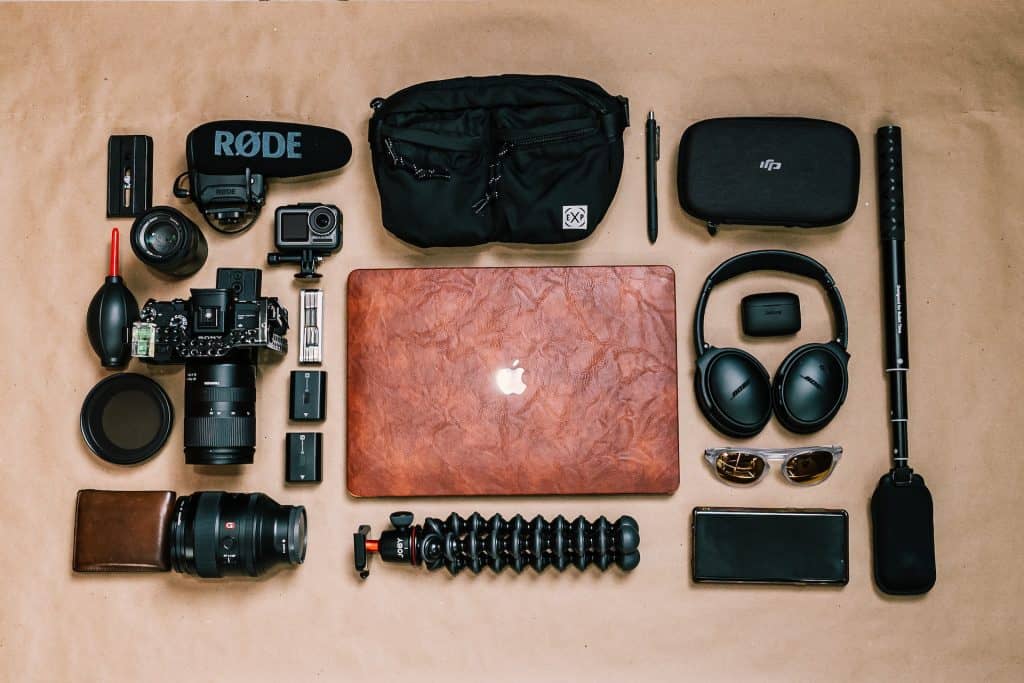
Just started Year 11 Standard and Advanced English Module A: Contemporary Possibilities and have to study a multimodal text but have no idea what it is?
Don’t sweat!
We’re going to explain what exactly a multimodal text is, give you some examples of multimodal texts and teach you how to respond to one and get that Band 6 in HSC English!
So, what are you waiting for? Let’s get into it!
What is a ‘Multimodal Text?’
Types of Multimodal Texts
Why Should You Prepare For A Multimodal Text?
Multimodal Texts Examples
How to Respond to a Multimodal Text
Analysed Example of a Multimodal Text
What is a ‘Multimodal Text?’
Put simply, a multimodal text is a text which communicates meaning in more than one way, so any text which incorporates more than one of these kinds of communication is multimodal.
For instance, film can be focussed on within ‘Contemporary Possibilities,’ because it uses the modes of representing (visual imagery) and speaking to communicate.
However, there’s a big chance you could study something more complex.
For instance, BBC’s ‘Sherlock’ is given as the focus text in NESA’s sample unit. As well as communicating through speech and image, it also communicated with print, in the social media presence and blog that its creators published.
Therefore, you should know that multimodal texts have at least two of the following modes and meaning systems (aka how meaning is communicated in a text):
- Linguistic: spoken and written language in relation to vocabulary, generic structure and grammar
- Visual: uses music, sound effects, noises, ambient noise and silence
- Audio: still and moving images — think about colour, salience, visual symbols, shot framing, angles, camera movement
- Gestural: body, hands and eye movement, as well as facial expression and body language
- Spatial: relevant to the environment and architectural space being used in terms of proximity, direction, layout, position and how objects have been organised in the space

Types of Multimodal Texts
Multimodal texts can come in a range of forms. Some of these include films, infographics, books, emails, podcasts, animation, advertisements, broadcasts, blogposts, letters, videos, presentations, comics and annotated images.
Advertisements
An advertisement is a form of content that promotes a product, service, or idea. There are different types of advertisements such as TV commercials, billboards, ads in newspapers and magazines, and sponsored content on social media platforms. Most advertisements have a mix of visual, audio and written modes in the text.
Animation
Animation is a form of visual content that is created by a sequence of static images to form the illusion of motion. It used for films, television shows, video games and visual effects on websites.
Books
A book is a medium for recording information in the form of writing and/or images. Books can have many purposes, including reading, education, reference, and entertainment — whether they are fiction or non-fiction, books often use storytelling techniques to convey their message.
Blogpost
Blogposts are content published on a blog. Blogposts are made up of text, images, videos, or other multimedia elements. It is typically written in an informal tone and records the blogger’s personal opinion or experiences on a particular subject.
Documentary
A documentary is a non-fiction film that educates the audience on a particular topic. Interviews, reenactments and archival footage are often used to portray the message of the documentary. Topics include biographies of historical figures, a contemporary social issue, to the exploration of historical events.
Film
A film contains a series of images projected onto a screen to form the illusion of a moving picture. The use of sound accompanies the images, as well as post-production editing that may add text to signpost extra information.
Infographic
An infographic (a portmanteau for “information graphic”) is a visual representation that depicts complex information in simple visual elements.They can be anything from charts to diagrams, or from illustrations to maps. For example, diagrams are often used in news articles to give the reader quick and digestible bites of information.
Presentation
A presentation is a collation of slides or other visual aids that conveys information to an audience. Presentations can include images, images, audio aids, videos and other elements. They are often delivered in a live setting such as a meeting or conference, or recorded online.
Video
A video is a collation of moving images. They can be recorded and processed by a variety of devices such as cameras, smartphones and drones. The purpose of a video is to be played back on televisions, computers and phones for entertainment, education, information and other purposes.
Importance of Preparing For A Multimodal Text?
While there’s a chance you could be prescribed a film, you still need to understand the implications of multimodality.
Take a look at the NESA’s syllabus description on Contemporary Possibilities.

Excerpt of Contemporary Possibilities syllabus from NESA
Consider the lines: “analyse and interpret the ways composers use and manipulate a variety of aural, language and visual devices to shape our understanding of what we listen to, read or view and may explore notions of hybridity and intertextuality.”
‘Hybridity’ simply means the meanings created through multiple modes of communication, and ‘intertextuality’ means the use of another text within a text.
The current Preliminary HSC and HSC courses are designed for a changing world where new kinds of technology are giving creators new ways to express meaning. It’s therefore in your best interests to become aware of how different kinds of communication can affect how texts are received and interacted with.
Examples of Multimodal Texts
To familiarise yourself with different multimodal texts, check out these examples!
Junko’s Story: Surviving Hiroshima’s Atomic Bomb

Junko’s Story is a historical biography of Junko Morimoto, a Japanese writer and illustrator, who survived the 1945 bombing of Hiroshima. The chronicling of her survival as a thirteen-year-old girl is depicted in SBS’s interactive news-article.
The article includes written first-person text, tables, maps and secondary photos of items that survived the atomic bomb.
Australian War Memorial

This is a website that digitally renders information about the Australian War Memorial, including a collection of Australian military events, units, places and members of the Australian armed forces.
This one’s NESA approved — it used to be a prescribed text for Year Twelve!
17776: an American Football Story

17776 is a digital sci-fi narrative by Jon Bois. The story is set in the distant future where humanity achieves immortality. It uses a never-ending game of football to explore time and memory.
The website uses interactive elements, GIFs, images, Youtube videos and text.
Antarctic Dispatches

Antarctic Dispatches is your regular old blogpost. It documents the Columbia University team’s 2016 journey to Antarctica and provides scientific reporting of the ice melting due to climate change.
Like any blog, it uses anecdotal writing, images and hyperlinking. Unlike a personal blog, it uses a formal tone — not all blogs are written in an informal tone, so be careful when analysing your text!
How to Respond to a Multimodal Text
Step 1: Find a Multimodal Text!
While if you were required to find your own multimodal text, you could always use a film, it would be better to use one which will allow you to discuss its hybridity. So: you could look for an interactive graphic novel (like The Boat) or a museum’s website’s virtual tour.
Check out one of the multimodal texts we listed above!

Step 2: Get Started On Creating TEE Tables
Just as with other texts, TEE tables are a great way of collating techniques and keeping a bank of evidence as you progress through your study of a text. Having a tabulated list of evidence will also help you to check at a glance that you’re maintaining a range of modally different techniques.
There’s a big chance that you’ll need to address both visual techniques and literary techniques as most of the multimodal texts use both.
But, you have to keep in mind the other elements unique to a certain multimodal texts — for example, websites also have an interactive nature.
For the best analysis, you need to think about what a multimodal text does that would not be possible if it weren’t for its use of multiple modes.
Need help with your analysis? Our Castle Hill English Tutors can help build your English skills, motivation, and confidence through quality 1 on 1 and small group English tutoring.
Step 3: Practise Writing!
The best way to get better at writing is through structured, regular practise!
At the moment, there’s no previous model examples for analysis of multimodal texts, but you can’t go wrong with scrutinising the marking rubric, drafting and redrafting, being sure you answer the question, and showing an understanding of the unique opportunities for the making of meaning offered by multimodal texts.
Analysed Example of a Multimodal Text
Let’s look at Matt Huynh’s multimedia adaptation of Nam Le’s ‘The Boat’.
Let’s say that task tells us to discuss how the text’s hybrid form allows for the creation of mood. As with other texts, you can’t go wrong with a good TEE table!
| Technique | Example | Effect |
|---|---|---|
| Simile | “face as smooth and impassive as that of a ceramic toy soldier.” | The use of a simile comparing allows Huynh to convey the numbness that Truong is feeling due to his distress and unease. |
| Salience | The blankness of Truong’s face compared to the murky grey around it. | The salience made through contrast draws the audience’s attention to Truong’s face, which complements the print description. |
| Interactivity | As the audience scrolls down the graphic novel, the picture consistently moves side to side. | This interactive element allows for a greater sense of immersion, as the unsteadiness and sense of tension felt by Mai as she searches for Truong is emphasised. |
While this is a basic example, it highlights the grasp of ‘hybridity’ needed in order to analyse a multimodal text: I’ve discussed how different modes (visual and print) have been used together in order to create an atmosphere of unease and tension.
I’ve also discussed the interactive element of the text, which shows an understanding of this text’s uniquely multimodal properties.
On the hunt for other Year 11 English resources?
Check out our other articles, guides and practice questions below:
- 30 Practice Questions for Year 11 Advanced Module A: Narratives that Shape Our World
- Band 6 Guide to the Year 11 English Advanced Module B – Critical Study of Literature
- How to Write an Effective Year 11 English Reflection Statement
- 20 Practice Questions for Year 11 English Standard Module B – Close Study of Literature
- Band 6 Guide to the Year 11 English Common Module: Reading to Write
Need some extra help analysing your multimodal text?
We pride ourselves on our inspirational coaches and mentors!
We offer tutoring and mentoring for Years K-12 in a large variety of subjects, with personalised lessons conducted one-on-one in your home, online or at one of our state of the art campuses in Hornsby or the Hills! If you’re looking for support with multimodals, look no of further than North Shore English tutoring!
To find out more and get started with an inspirational tutor and mentor get in touch today!
Give us a ring on 1300 267 888, email us at [email protected] or check us out on TikTok!
Cameron Croese is a qualified English teacher, who has a Bachelor of Education (Secondary) / Bachelor of Arts (English) from Macquarie University and is currently undertaking a Masters of Education in Melbourne. A long-time Art of Smart coach, Cameron has supported over 60 students from Years 7 to 12! When not studying, Cameron is an avid writer, having won several awards for short stories, including the Alan Marshall Short Story Award.


